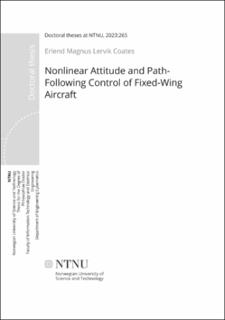| dc.description.abstract | The last decade has seen an increased use of small fixed-wing unmanned aerial vehicles (UAVs) in a multitude of civil, commercial and scientific applications. Autopilots are automatic control systems that provide the basic low-level control functions that maintain aircraft attitude, speed, altitude and course heading. As we move towards higher levels of automation, robust and reliable autopilots are needed to enable safe and efficient autonomous operation of UAVs. Conventional autopilots are designed using linear control theory to operate close to some nominal operating conditions. However, the underlying physics are highly nonlinear, causing performance deterioration and, possibly, instability when approaching the edge of the flight envelope.
This thesis focuses on applying state-of-the-art nonlinear control algorithms to develop autopilots that can provide fixed-wing UAVs with the capability to operate in extended flight envelopes, with more aggressive manoeuvres, and in a wider range of weather conditions. Although most of the results of this thesis are valid for fixed-wing aircraft in general, simulation studies and experimental trials are carried out for fixed-wing UAVs.
The thesis contributions are presented in three parts. Part I of the thesis develops novel geometric reduced-attitude controllers, particularly wellsuited for fixed-wing aircraft performing banked-turn manoeuvres. Instead of using roll and pitch (Euler) angles, a global, singularity-free representation on the unit two-sphere is used that is independent of the yaw/heading angle of the aircraft and allows for geodesic (shortest path) rotations. The reduced-attitude representation lets us decouple the control objective into two parts: 1. Reduced-attitude (roll/pitch) control, and 2. Control of the angular velocity about the inertial z-axis (turn rate control). Posing the control problem on the sphere has the advantage of opening up a wide range of tools for control systems on spheres, including different choices of potential functions and methods for global stabilization and tracking using hybrid control. Almost-global and global asymptotic stability is proven using Lyapunov methods for smooth and hybrid controllers, respectively. Adaptive and robust variants of the control design are developed to account for un certain aerodynamic effects and turbulent wind disturbances. The control performance is demonstrated in MATLAB simulations as well as using more realistic software-in-the-loop simulations.
In part II, we revisit the path-following guidance problem in three dimensions. First, by formulating the path-following error directly in the inertial frame, we propose a class of guidance laws for regular parameterized paths that, unlike most approaches existing in the literature, do not require the explicit construction of a path frame. Based on an inner-outer loop control paradigm, the guidance law generates a normal acceleration command that is normal to the flow-relative velocity vector (as the lift force). This allows for a natural decomposition of the desired vehicle acceleration for aerial vehicles in coordinated turns: tangential acceleration for airspeed control and normal acceleration for guidance generated through bank-to-turn manoeuvres, i.e., by tilting the lift vector. By using cascade arguments, we show that the proposed design leads to almost global stability results and thus relaxes the set of feasible initial conditions compared to existing methods. The efficacy of the proposed guidance law is demonstrated in a simulation study.
In part III, we explore the use of deep reinforcement learning (DRL) for attitude control of UAVs. We show that DRL can successfully learn to perform attitude control of fixed-wing UAVs, requiring as little as three minutes of flight data. The proposed method is based on the Soft Actor-Critic algorithm and improves upon the data efficiency of the existing literature by at least an order of magnitude, providing an important step towards enabling the learning of reinforcement learning controllers entirely on the real UAV. We initially train our model in a simulation environment and then deploy the learned controller on the UAV in flight tests, demonstrating comparable performance to the state-of-the-art ArduPlane PID attitude controller with no further online learning required. | en_US |
